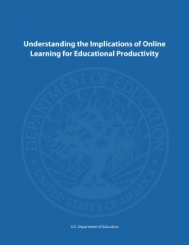Promoting Grit, Tenacity, and Perseverance - U.S. Department of ...
Promoting Grit, Tenacity, and Perseverance - U.S. Department of ...
Promoting Grit, Tenacity, and Perseverance - U.S. Department of ...
Create successful ePaper yourself
Turn your PDF publications into a flip-book with our unique Google optimized e-Paper software.
Draft<br />
KIPP (Knowledge is Power Program)<br />
KIPP started as a middle school model in low-income communities developed by Teach for America alumni<br />
Mike Feinberg <strong>and</strong> Dave Levin. After establishing many successful middle schools, they eventually exp<strong>and</strong>ed to<br />
elementary <strong>and</strong> high schools as well. Overall, their students are 59% African American <strong>and</strong> 36%<br />
Latino/Hispanic; 87% receive free or reduced-price meals.<br />
KIPP made national news in 1999 when KIPP Academy middle school’s first graduating eighth-graders had the<br />
five highest test scores in all <strong>of</strong> New York City. However, years later, data on the students graduating from KIPP<br />
middle schools would reveal that many struggled academically in non-KIPP high schools <strong>and</strong> college. According<br />
to their website, “As <strong>of</strong> fall 2011, 36 percent <strong>of</strong> KIPP students who completed eighth grade at KIPP ten or more<br />
years ago have graduated from a four-year college.” Their high rate <strong>of</strong> student entry into 4-year colleges (84%)<br />
<strong>and</strong> low rate <strong>of</strong> college graduation (36%) spurred KIPP leadership to evaluate what was missing in their schools.<br />
They began to hypothesize that their alumni who succeeded could be characterized as having the intangible<br />
skills consistent with important noncognitive factors. KIPP then became strongly influenced by the work <strong>of</strong><br />
Positive Psychology researchers, such as Duckworth <strong>and</strong> Seligman, as the field was beginning to show that<br />
long-term success was just as contingent on noncognitive abilities as intellectual abilities.<br />
For the last several years, KIPP has been developing <strong>and</strong> implementing a character education model to foster<br />
key noncognitive abilities, with a particular emphasis on grit. They teach these qualities as skills that can be<br />
worked on <strong>and</strong> improved, <strong>and</strong> strive to create school-wide discourse around character. They emphasize many<br />
<strong>of</strong> the contextual factors <strong>and</strong> psychological resources in our model. For example, KIPP focuses heavily on goalsetting<br />
as a key motivating factor. Mitch Brenner, KIPP New York’s administrative lead on character<br />
development, runs teacher pr<strong>of</strong>essional development focused on goal-setting, with a special emphasis on giving<br />
students agency in creating their own goals. Importantly, KIPP also provides critical supports for students’<br />
striving to achieve their goals. For example, around mindsets, Carol Dweck’s “growth mindset” has been taught<br />
in KIPP schools for many years, <strong>and</strong> its messaging resembles the way that KIPP educators talk to students<br />
about the malleability <strong>of</strong> their character skills. Effortful control skills are taught as part <strong>of</strong> a weekly character<br />
class, through dual-purpose lessons with both academic <strong>and</strong> character objectives, <strong>and</strong> reinforced by public<br />
reminders. For example, students walk around school wearing shirts that read, “Don’t eat the marshmallow,” a<br />
reference to the classic self-control study in which children needed to abstain from eating a marshmallow in<br />
order to earn a reward (which we discuss in Chapter 2 in the section on Effortful Control). The Character Report<br />
Cards (see Chapter 3 for an example) are used as formative assessments to help students gauge <strong>and</strong> work on<br />
their own progress with the noncognitive factors.<br />
Evaluation data are not yet available about growth <strong>of</strong> noncognitive factors. However, data on achievement has<br />
been strong <strong>and</strong> positive. A study by Mathematica in 2010 matched KIPP students with similar peers at local<br />
schools <strong>and</strong> measured their achievement longitudinally. The study found that students attending a KIPP middle<br />
school had higher math achievement by .48 st<strong>and</strong>ard deviations, the equivalent <strong>of</strong> 1.2 years <strong>of</strong> learning or half<br />
the black/white achievement gap. The study also found reading achievement in KIPP schools was higher by .28<br />
st<strong>and</strong>ard deviations, the equivalent <strong>of</strong> .9 years <strong>of</strong> learning <strong>and</strong> a third <strong>of</strong> the black/white achievement gap.<br />
Project-based learning <strong>and</strong> design thinking models. These models include schools with<br />
intensive focus on learning strategies for accomplishing long-term goals <strong>and</strong> an emphasis on<br />
feedback <strong>and</strong> iteration. In project-based learning (PBL), students take on real-world problems in<br />
any discipline <strong>and</strong> develop long-term projects around these problems. Connections to the real<br />
world provide a motivating context, <strong>and</strong> long-term projects provide opportunities to develop<br />
21st-century skills such as problem-solving, collaboration, researching, <strong>and</strong> communication. In<br />
particular, students learn important learning strategies <strong>and</strong> self-regulation skills necessary for<br />
perseverance over the long term to achieve the goals <strong>of</strong> a given project. They may learn skills<br />
61
















